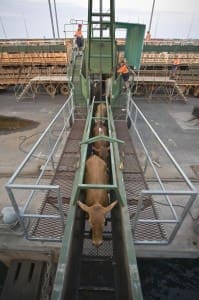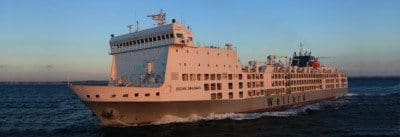A tough year for livestock exporters is showing few signs of easing in coming months, with the approaching wet season set to make it harder to source cattle.
With cattle already in tight supply and restockers competing heavily for available numbers after recent rain, the market for steers and heifers suitable for export stands close to an all time high at 365c/kg ex-Darwin.
Market conditions in Indonesia and Vietnam are also adding to the pressure exporters and importers are feeling in the current market.
The sudden introduction a new breeder import policy by the Indonesian Government in early September, just as shipping was being marshalled for the anticipated release of third-trimester permits, resulted in no cattle being shipped at all during the month, resulting in substantial demurrage costs for many exporters who had ships on charter.
The same policy continues to disrupt the trade, with many normal customers still unable to access import permits because they have not yet agreed to the new breeder import policy.
The new rule requires that for every five feeder or slaughter animals imported, one breeding animal must also be imported, a difficult and expensive policy for importers with feedlots and no land for breeding cattle to comply with.
The Indonesian Government is also requiring importers to sell finished cattle from their feedlots at a low price point, as it tries to keep the price of beef affordable for consumers.
This means exporters and importers are unable to pass on the high costs they have to pay for Australian cattle, causing losses for their businesses.
Orders to Vietnam have also wound back due to recent ESCAS issues and an abundant supply of cattle in the market. Talk of South American countries gaining protocol access to Vietnam has also been increasing in recent months.
Restocker competition keeping prices high
While processor grid prices and the EYCI have eased by 20-25c/kg in recent weeks, prices for live export steers in the north have not shown similar declines.
This appears mainly to do with the strength of new competition coming again from restockers, who are now in the market to buy cattle to put on new season grass.
For example, a large line of Brahman steers from NW Qld, which would usually go straight to live export, are instead heading south after they were bought by a channel country restocker for 375c/kg last week.
Buying high and selling low for extended periods is obviously not good for business, while exporters with vessels on charter continue to absorb substantial demurrage costs which have added to balance sheet difficulties since the start of September.
Repositioning of vessels
Exporters with long-term shipping commitments, either through vessels they own or lease, are perhaps most exposed in the current low-supply cycle.
Many are not renewing lease arrangements as fixed-term charters come back up for renewal, and are moving instead to voyage-based charters when it makes financial sense to conduct a trade, as recently reported.
Exporters who started the year with five vessels are now down to one.
Others are repositioning carriers to find work in markets outside of Australia.
It is worth remembering that Australia’s livestock export industry is only a small part of the global trade, with well over 200 livestock vessels operating worldwide.
In its recent financial report Wellard Rural Exports noted that as a consequence of increased cattle prices and reduced supply in Australia, it had reduced its business here in favour of increasing its business in South America.
Wellard testing market for two of its five ships
However, with a fleet of five large vessels, Australia’s largest livestock exporter is also clearly seeking to ease its exposure.
Beef Central has learned this week that Wellard is testing the market for the potential sale of two of its five large livestock carriers.
The company has gone to the market seeking expressions of interest for the sale of its sister ships the MV Ocean Swagman and the MV Ocean Outback.
Both were launched in 2010 and each has a capacity to carry 7000 cattle or 26,000 sheep or a combination of both.
Wellard told Beef Central it had received a number of unsolicited inquiries from Middle Eastern and Chinese buyers to purchase vessels.
“In response, Wellard elected to commence a formal process to test the market for the potential sale of either the M/V Ocean Swagman and/or the M/V Ocean Outback,” the spokesperson said in a statement supplied to Beef Central.
“No decision has been made to complete a sale.
“Wellard is constantly reviewing its fleet so that it can extract maximum efficiency and return from its maritime assets. This is a process Wellard has regularly undertaken to make sure it always has the right fleet for the right trade.
“Whether a sale is progressed will depend on the offers received and the board and management’s view of the same.”
Minimising losses
The main challenge confronting live exporters, like any buyer of Australian cattle at present, is supply, which is cyclical in nature and should ease as wall-to-wall grass around much of the country triggers herd rebuilding and improved supply in a year or two.
Until then the focus is likely to be purely on minimising losses and maintaining financial viability.
The cyclical downturn is affecting all exporters big and small.
Elders recently announced it is pulling out of its long running involvement in live exports after reporting a loss of $2.9 million from that section of its business for the six months to March 30, this year.
Wellard has become another public face of the challenging conditions for exporters since its public listing in December last year.
Since then it has had to downgrade its profit forecast three times to meet its continuous disclosure obligations, attributing the downturn to tight supply, high Australian cattle prices and the unanticipated costs of two ship breakdowns.
Highlighting the challenges facing the business in the current financial environment, independent auditor PWC pointed to ‘material uncertainty regarding Wellard’s continuation as a going concern’ in its annual report lodged late last month.
The auditor said Wellard’s annual report showed the company had a ‘working capital deficiency of $110.3 million as at 30 June 2016.
“(This) comments on the ability of the Group to continue as a going concern being dependent on the Group having sufficient funds available to continue normal business operations and remedy banking covenant breaches.
“These conditions, along with other matters as set forth in Note 1(c) indicate the existence of a material uncertainty that may case significant doubt about the Group’s ability to continue as a going concern and therefore the entity may be unable to realise its assets and discharge its liability in the normal course of business, and at amounts stated in the financial report.”
Wellard however has told Beef Central the note was a reflection of ‘an accounting standard rather than commercial reality’.
The company says it is not in default of any debt facility.
A breach of an undertaking in its working capital facility had occurred but a waiver and extension had been obtained and would be remedied before an event of a default, the Company’s annual report said.
In effect, it said, the working capital breach of undertaking had resulted in a reclassification of borrowings from non-current (payable in more than 12 months) to current (payable within 12 months), even though those loans do not actually have to be paid back in the next 12 months. This created the technical working capital deficiency of $110.3m.
“Wellard has obtained a waiver and extension to the remedy period to 28 February 2017 before it will become an event of default. Wellard expects that this will be finalised prior to 28 February 2017,” a spokesperson said.
Light on the horizon
Meanwhile, it is worth noting that despite difficult market conditions right now for exporters, the picture confronting them looking forward will give them some optimism.
After a high level meeting between Australian and Indonesian representatives in Jakarta on Monday, a new working group has been established to meet the objectives of helping Indonesia to build its breeding capacity, and maintaining supply via the existing live cattle and boxed beef.
Also, it seems only a matter of time before long-anticipated demand from China turns into larger volume shipments.
Several new feedlot and abattoir developments being built to take Australian cattle are getting closer to completion.
While the current high price of cattle may dampen initial Chinese demand somewhat, there is a strong feeling that the first sea-based exports of Australian cattle to China will occur within the first half of next year.
Wellard has invested heavily in China and in a sign of the importance it is attaching to the market, it has just appointed one of its most senior people, Bernie Brosnan, to the role of General Manager-China.
Mr Brosnan will be tasked with establishing Wellard’s supply chain in Australia to procure slaughter and feeder cattle.
“This new division is expected to become an extremely important division for Wellard as we expand our trading market,” a Wellard spokesperson told Beef Central.
“Bernie will initially develop the business within our depots on a national basis,” a Wellard spokesperson said.
In other personnel changes confirmed by Wellard to Beef Central this week:
- Gemma Lomaxb ecomes General Manager for Northern Australia, a promotion from her operations and control & traceability roles.
- Colin Webb has accepted a new challenge as the new General Manager – South America on a permanent basis, reporting to Business Development Officer South America Domenico Bazzoni. He has relocated to Brazil, taking with him his demonstrated expertise in reporting and budgeting structures used in building the successful Breeding and Dairy Division. This move will add an Australian flavour to the team and seeks to further strengthen the company’s current and new client relationships in the region.
- Ben Giblett has been based in South America for some time and accepted the role of Export Operations Manager whereby he will be given the responsibility of managing all aspects of South American Export Operations. Ben will continue in this role to build relationships with stakeholders, and significantly improve the vessel loading times and cattle management.
- Andrew Martin has been appointed as Export Operations Manager located in Fremantle. Andrew’s role has a particular focus on improving the performance of livestock on the vessels through transit and discharge operations. He will also work to educate and coordinate the Stockmen, Crew and Officers towards improving weight gain and voyage performance results.





There seems to be very little differentiation between the ownership of and control of assets between Wellard Group Holdings ,owned by Mauro Balzarini and Wellard, the publicly listed entity. Hang on little shareholders ,the ships might not be the only things in unpleasant waters